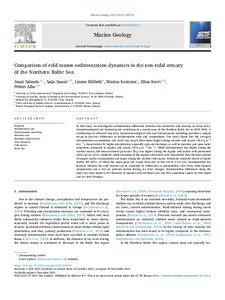Comparison of cold season sedimentation dynamics in the non-tidal estuary of the Northern Baltic Sea
Blåfield Linnea; Saarni Saija; Salmela Jouni; Kasvi Elina; Katainen Markus; Alho Petteri
https://urn.fi/URN:NBN:fi-fe2022012711105
Tiivistelmä
In this study, we investigated sedimentation differences between two distinctive cold seasons, in terms of hydrometeorological and hydrodynamic conditions, in a coastal area of the Northern Baltic Sea in 2018–2020. A combination of sediment trap data, hydrometeorological data and hydrodynamic modelling provided a unique set-up to discover differences in sedimentation rates and compositions. Our study shows that the averaged sedimentation accumulation rate (SAR) was nearly three times higher during warmer cold season (30.9 g m−2 day−1), characterised by higher precipitation, especially rain and discharge, as well as snowless and open water conditions, compared to regular cold season (10.6 g m−2 day−1). While sedimentation was higher during the warmer season, the mean sediment grain size (D50) was higher during the regular cold season with permanent snow and ice cover. Similarly, while sediments of the regular cold season were organically rich, the total amount of organic matter accumulation was larger during the warmer cold season. Sediments consisted mostly of clastic matter (85–89%), of which the mean grain size varied from clay to fine silt (0.3–3.0 μm). Sedimentation differences between the cold seasons can be explained by differences in precipitation, river flow, wind-induced resuspension and a low air pressure system forcing sea level changes. Sedimentation differences along the study bay were found to be connected to channel cross-sectional area and flow conditions caused by river input and sea level changes.
Kokoelmat
- Rinnakkaistallenteet [27094]
